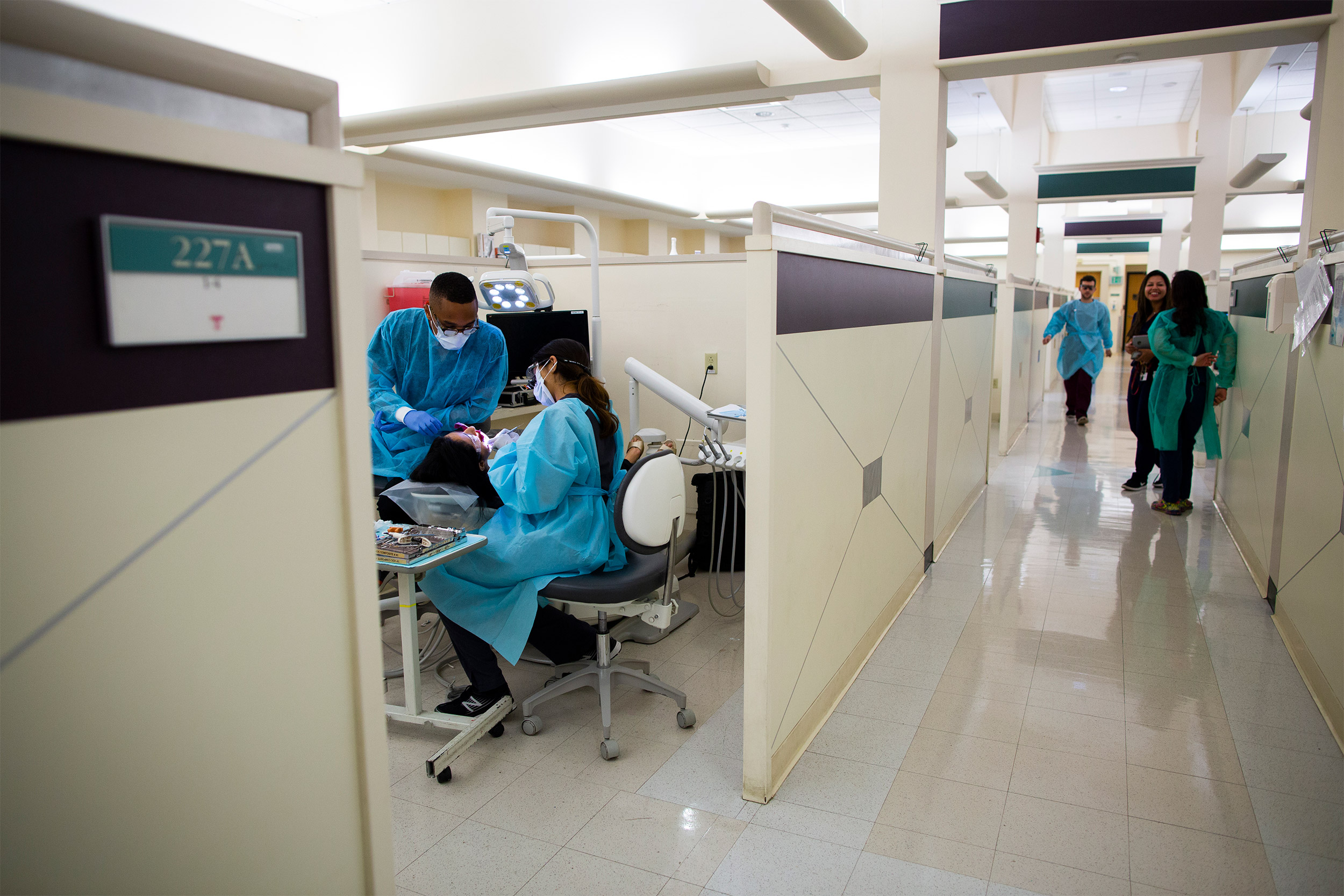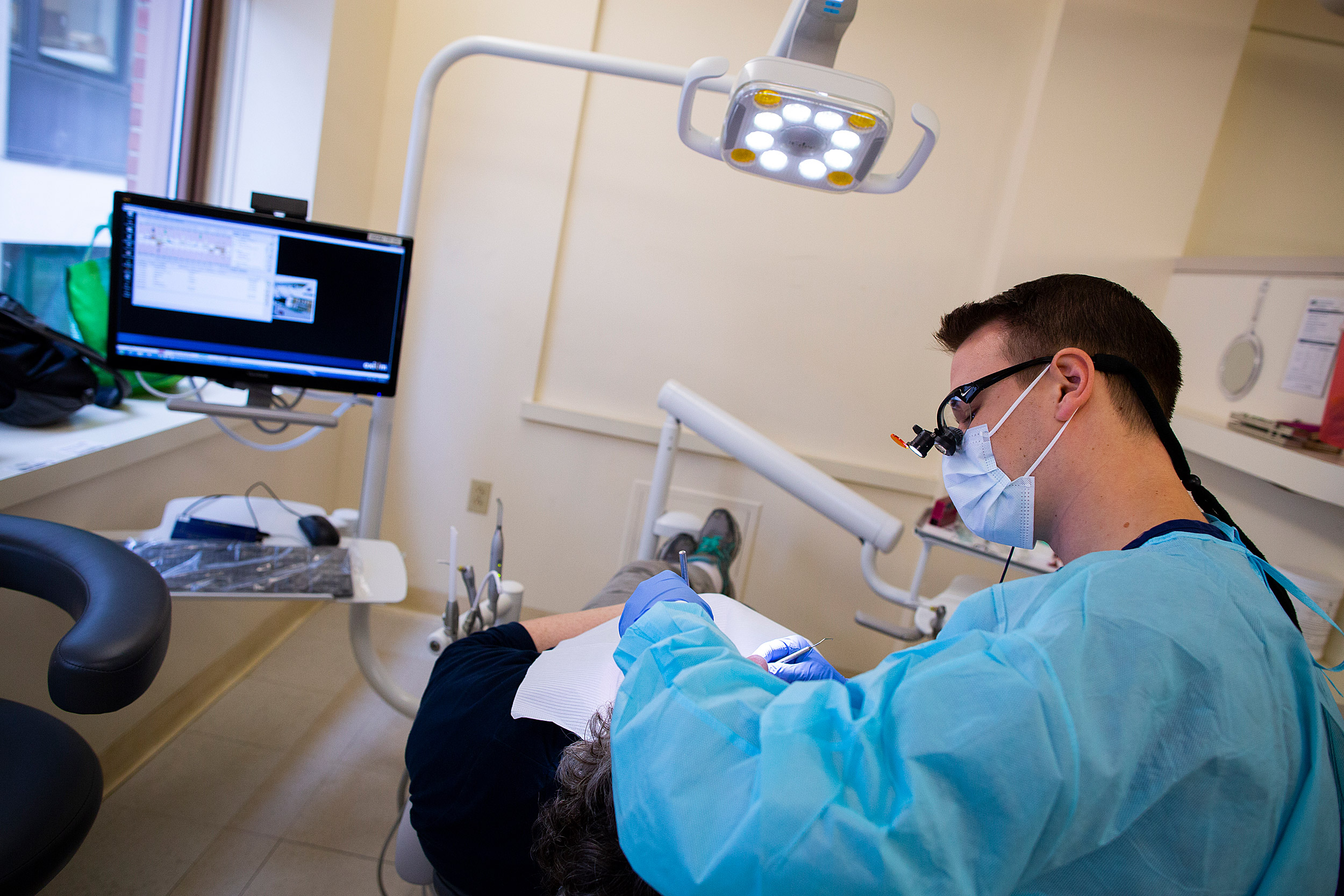
Photos by Stephanie Mitchell/Harvard Staff Photographer
Some lessons feel like a root canal, and that’s just fine
Harvard dental students’ hands-on learning helps fill gaps in care
In 1983, Susan Pillsbury was a student at the Massachusetts College of Art and Design in Boston, a long way from her Maine hometown. Luckily, when she needed a dentist, she only had to travel around the corner, to the Harvard Dental Center on Longwood, where the care provided by student dentists still comes at a price attractive to a college kid.
“I was just a broke student and someone recommended the Dental School to me,” Pillsbury recently recalled, sitting in an examination chair at the center. “I’ve been coming here since.”
Pillsbury, now a Brookline resident, has collected half a dozen crowns, a bridge, and an implant at the center over the years. Cost is one factor that keeps her coming back, but there are many others.
“I like getting to know the students, too,” she said. “They seem to be the cream of the crop. They do a really good job, and everything gets checked by the instructors.”
The Harvard Dental Center has an active base of more than 38,000 patients. It is the only arm of Harvard that provides direct patient care (students at Harvard Medical School do their clinical studies at affiliated hospitals). The faculty group practice — dental patients are divided among three practice groups — recorded more than 18,000 visits last fiscal year.
The other two practice groups — made up of the School of Dental Medicine’s 240 students and collectively known as the Teaching Practices — draw more than 26,000 patient visits a year. One practice group consists of postdoctoral students, who have already received a general dentistry degree and have advanced to one of the more than 12 specialties the School offers.
The other tier of dental practice is provided by students working on their first dental degree, doctor of dental medicine. The students provide care under the guidance of instructors and after going through simulations with dummies and digital models. Students spend their first year studying with peers at the Medical School. They transition to the Dental School in their second year, with patient care beginning in year three.
“The clinical experience students receive [seeing patients] is the most important to their education,” said German Gallucci, faculty chair of the dental center and the Raymond J. and Elva Pomfret Nagle Associate Professor of Restorative Dentistry and Biomaterials Science. “It is in their clinical training that they take the first steps as dental medical professionals. We see them transitioning to the different stages of their clinical experience, becoming confident clinicians at the end of their education.”
Working on a patient for the first time is a watershed in dentists’ careers, Gallucci said, and a moment that sticks in the memory. In his case, the patient was entirely toothless, and needed a complete denture.
“It’s a very special moment in the life of any physician,” Gallucci said.
“The bonding of student to patient is something wonderful to experience. They’re helping each other.”
German Gallucci, faculty chair of Harvard Dental Center

Over the course of their education, Gallucci said, students are exposed to a range of patients whose cases require different procedures, providing a wide variety of clinical experiences.
The center also serves the community by providing affordable access to oral health, he said. The student teaching clinic costs less than the faculty group practice, whose rates are equivalent to those of private practices. That allows people looking for dental care at a reduced rate — including those who might otherwise forego dental care — to get the services they need.
But Gallucci noted that the student-patient relationship is a two-way street, and that some patients come back because they enjoy helping students learn.
“The bonding of student to patient is something wonderful to experience. They’re helping each other.”
On a recent Monday at the Dental Center, a class of second-year students was focused on model teeth in a preclinical lab, while grad student Rami Albahri was working in the School’s new digital dentistry lab, designing a procedure to replace a patient’s missing tooth with a titanium implant.
Albahri, who holds a doctor of dental surgery degree from New York University and is working toward a master of medical sciences in prosthodontics, said that the experience of completing a diagnosis and designing a treatment plan for a patient reminds him why he decided to become a dentist.
Two floors up from the digital lab, a large, bright room is segmented into smaller cubicles. There, dozens of dental students meet with patients under the watchful eye of circulating dental residents. In a similar cubicle just off the main space, fourth-year student Tom Ferlito took a break from his examination of Pillsbury.
Ferlito, who plans to start an orthodontics residency program after graduating in the spring, has met with about 60 patients during his student career. Some have come in once for a simple procedure, while others he sees regularly.
“It’s cool seeing someone like Susan coming here for 35 years … knowing all the people Susan helped teach over the years as well,” he said.
Winthrop Reed, a Rhode Island real estate agent, started coming to the Dental Center six years ago at the recommendation of his daughter, who works at MassArt. Reed, visiting for the final fitting of a replacement denture, said that he enjoys the center’s learning environment.
“Going to the dentist isn’t supposed to be fun, but it’s a lot of fun here,” he said. “What makes it fun is the learning, the academic atmosphere, the bright young people. The professors are just outstanding. It’s just being in this environment. I really enjoy it.”







